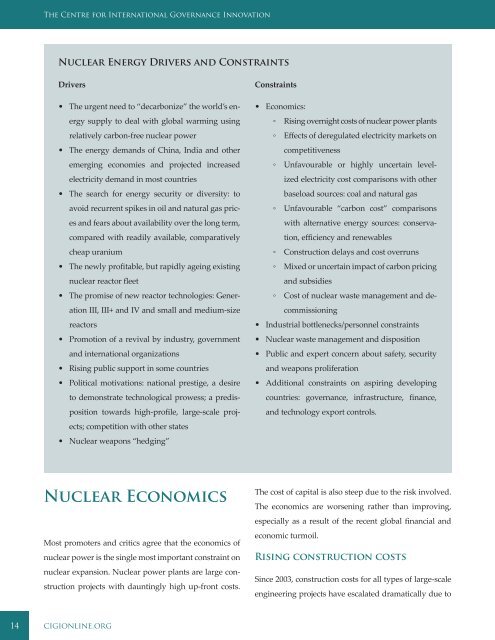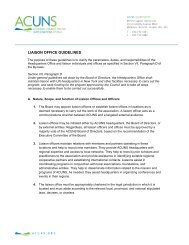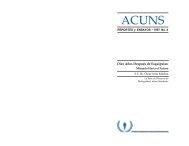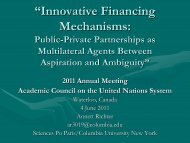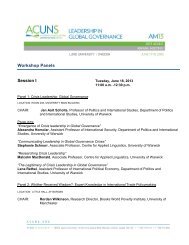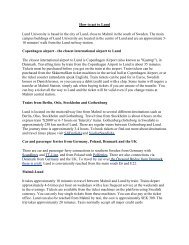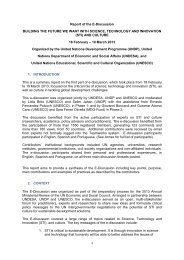THE FUTURE OF NUCLEAR ENERGY TO 2030 AND ITS ... - acuns
THE FUTURE OF NUCLEAR ENERGY TO 2030 AND ITS ... - acuns
THE FUTURE OF NUCLEAR ENERGY TO 2030 AND ITS ... - acuns
Create successful ePaper yourself
Turn your PDF publications into a flip-book with our unique Google optimized e-Paper software.
The Centre for International Governance Innovation<br />
Nuclear Energy Drivers and Constraints<br />
Drivers<br />
• The urgent need to “decarbonize” the world’s energy<br />
supply to deal with global warming using<br />
relatively carbon-free nuclear power<br />
• The energy demands of China, India and other<br />
emerging economies and projected increased<br />
electricity demand in most countries<br />
• The search for energy security or diversity: to<br />
avoid recurrent spikes in oil and natural gas prices<br />
and fears about availability over the long term,<br />
compared with readily available, comparatively<br />
cheap uranium<br />
• The newly profitable, but rapidly ageing existing<br />
nuclear reactor fleet<br />
• The promise of new reactor technologies: Generation<br />
III, III+ and IV and small and medium-size<br />
reactors<br />
• Promotion of a revival by industry, government<br />
and international organizations<br />
• Rising public support in some countries<br />
• Political motivations: national prestige, a desire<br />
to demonstrate technological prowess; a predisposition<br />
towards high-profile, large-scale projects;<br />
competition with other states<br />
• Nuclear weapons “hedging”<br />
Constraints<br />
• Economics:<br />
◦◦<br />
Rising overnight costs of nuclear power plants<br />
◦◦<br />
Effects of deregulated electricity markets on<br />
competitiveness<br />
◦◦<br />
Unfavourable or highly uncertain levelized<br />
electricity cost comparisons with other<br />
baseload sources: coal and natural gas<br />
◦◦<br />
Unfavourable “carbon cost” comparisons<br />
with alternative energy sources: conservation,<br />
efficiency and renewables<br />
◦◦<br />
Construction delays and cost overruns<br />
◦◦<br />
Mixed or uncertain impact of carbon pricing<br />
and subsidies<br />
◦◦<br />
Cost of nuclear waste management and decommissioning<br />
• Industrial bottlenecks/personnel constraints<br />
• Nuclear waste management and disposition<br />
• Public and expert concern about safety, security<br />
and weapons proliferation<br />
• Additional constraints on aspiring developing<br />
countries: governance, infrastructure, finance,<br />
and technology export controls.<br />
Nuclear Economics<br />
Most promoters and critics agree that the economics of<br />
nuclear power is the single most important constraint on<br />
nuclear expansion. Nuclear power plants are large construction<br />
projects with dauntingly high up-front costs.<br />
The cost of capital is also steep due to the risk involved.<br />
The economics are worsening rather than improving,<br />
especially as a result of the recent global financial and<br />
economic turmoil.<br />
Rising construction costs<br />
Since 2003, construction costs for all types of large-scale<br />
engineering projects have escalated dramatically due to<br />
14 cigionline.org


